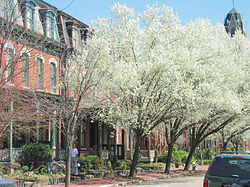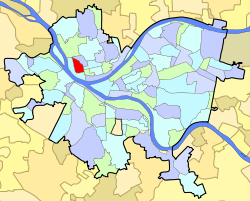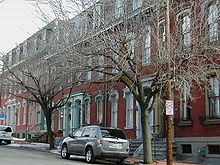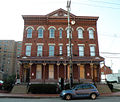- Manchester (Pittsburgh)
-
Manchester — Neighborhood — Liverpool Street in Manchester Location of Manchester in Pittsburgh Coordinates: 40°27′18″N 80°1′30″W / 40.455°N 80.025°WCoordinates: 40°27′18″N 80°1′30″W / 40.455°N 80.025°W Country  United States
United StatesState  Pennsylvania
PennsylvaniaCity  Pittsburgh
PittsburghArea – Total 0.7 km2 (0.279 sq mi) Population (2000) – Total 2,506 Manchester Historic DistrictArea: 51.6 acres (20.9 ha). Irregular pattern contained with Faulsey, Chateau, Franklin, and Bidwell Streets. Architectural style: Late Victorian NRHP Reference#: 75001611[1] Significant dates Added to NRHP: September 18, 1975 Designated CPHD: July 30, 1979[2] Designated PHLF: 1976[3] Manchester is a neighborhood on Pittsburgh, Pennsylvania's North Side. It has a ZIP code of 15233, and has representation on Pittsburgh City Council by the council member for District 6 (Northshore/Downtown Neighborhoods). The Pittsburgh Bureau of Fire houses 37 Engine and their foam unit in Manchester. The neighborhood includes the Manchester Historic District, which protects, to some degree, 609 buildings over a 51.6-acre (20.9 ha) area. The district was listed on the National Register of Historic Places in 1975.[1]
Contents
History
Manchester was part of the preserve of the Shawnee and Delaware Indians until the late eighteenth century, when all Indian lands in Pennsylvania were ceded to the State. In 1787, the land was surveyed and laid out as a section of the Reserve Tract, which was conferred as partial compensation to Pennsylvania's Revolutionary War veterans. Development in Manchester was encouraged by its division into large parcels of land, which were sold in conjunction with smaller town lots located in the city of Allegheny. Situated on one of Pittsburgh's few riverside plains, the level nature of the land allowed the community to be laid out in a standard grid pattern in 1832. Manchester became a borough in 1843, and in 1867 it merged with the city of Allegheny. In 1908, Allegheny was annexed to the city of Pittsburgh. Manchester was largely built up between 1860 and 1900, and attracted residents from Pittsburgh and Allegheny who desired to escape the density of the city. The installation of a streetcar network in the late nineteenth century linked Manchester to both cities, and stimulated its development as a suburban neighborhood. The community grew into a middle-class suburb, populated largely by local businessmen and their families.
The name Manchester originates from the English immigrants who first settled in the area and named the community after its industrial English counterpart. Manchester was an important industrial center for the city of Allegheny. The neighborhood was originally supported by industrial and wharf activity situated on the shore of the Ohio River, and factories loosely woven into the community. The Pittsburgh Locomotive and Car Works was a notable Manchester industry which produced the first Allegheny-built locomotive. Manchester's historical boundaries extended beyond Chateau Street to the shores of the Ohio River, with a neighborhoodcommercial district along Beaver Avenue. However, the western section of Manchester was severed in the 1950s when the elevated Route 65 Expressway was constructed. The expressway bisected the original neighborhood and created a separate commercial district called Chateau. Thus, today's Manchester is a remnant of a neighborhood that was once closely linked to the commercial and industrial sections closer to the river.
Manchester, along with other city neighborhoods, began a slow decline after 1915, when residents began to move to outlying suburbs to escape the encroaching and unpleasant effects of heavy industry. During the ensuing years, many of the finest houses in Manchester deteriorated and were demolished, and the neighborhood as a whole was neglected. In the 1970s, the Pittsburgh History and Landmarks Foundation (PHLF), the Manchester Citizens Corporation, the Urban Redevelopment Authority, and private developers formed a partnership that was successful in renovating many Manchester houses.
Manchester remains primarily a Victorian neighborhood. The term "Victorian," however, does not refer to a specific architectural style, but instead to the era of Queen Victoria's reign from 1837–1901. During that time, many different architectural styles were popular. "Victorian" styles prevalent in Manchester are the Italianate (ca. 1860–1885) and its contemporary, the French Second Empire (ca. 1855–1885); Richardsonian Romanesque and Queen Anne (ca. 1880–1900), which were superseded by the Classical and Colonial Revivals at the turn of the century. Examples of all these styles can be found in Manchester.
Surrounding Pittsburgh neighborhoods
Gallery
-
Conroy Junior High School (also known as Conroy Education Center), built in 1936, at the corner of Page and Fulton Streets.
References
- ^ a b "NPS Focus". National Register of Historic Places. National Park Service. http://nrhp.focus.nps.gov. Retrieved April 27, 2010.
- ^ "Local Historic Designations". Pittsburgh: Pittsburgh History & Landmarks Foundation. http://www.phlf.org/historic-plaque-program/local-historic-designations/. Retrieved 2011-08-09.
- ^ Historic Landmark Plaques 1968-2009. Pittsburgh, PA: Pittsburgh History & Landmarks Foundation. 2010. http://www.phlf.org/wp-content/uploads/2007/09/Historic-Plaques-2010b.pdf. Retrieved 2011-08-05.
See also
External links
U.S. National Register of Historic Places in Pennsylvania Topics 
Lists by county Adams • Allegheny • Armstrong • Beaver • Bedford • Berks • Blair • Bradford • Bucks • Butler • Cambria • Cameron • Carbon • Centre • Chester: (East | North | South) • Clarion • Clearfield • Clinton • Columbia • Crawford • Cumberland • Dauphin • Delaware • Elk • Erie • Fayette • Forest • Franklin • Fulton • Greene • Huntingdon • Indiana • Jefferson • Juniata • Lackawanna • Lancaster • Lawrence • Lebanon • Lehigh • Luzerne • Lycoming • McKean • Mercer • Mifflin • Monroe • Montgomery • Montour • Northampton • Northumberland • Perry • Philadelphia • Pike • Potter • Schuylkill • Snyder • Somerset • Sullivan • Susquehanna • Tioga • Union • Venango • Warren • Washington • Wayne • Westmoreland • Wyoming • YorkLists by city Pittsburgh • Lancaster • Philadelphia: (Center City | North | Northeast | Northwest | South | Southwest | West)Other lists Bridges (Covered Bridges) • National Historic Landmarks (Philadelphia) Category:National Register of Historic Places in Pennsylvania •
Category:National Register of Historic Places in Pennsylvania •  Portal:National Register of Historic PlacesCategories:
Portal:National Register of Historic PlacesCategories:- Historic districts in Pennsylvania
- National Register of Historic Places in Pennsylvania
- Neighborhoods in Pittsburgh, Pennsylvania
- City of Pittsburgh historic designations
- Pittsburgh History & Landmarks Foundation Historic Landmarks
Wikimedia Foundation. 2010.








